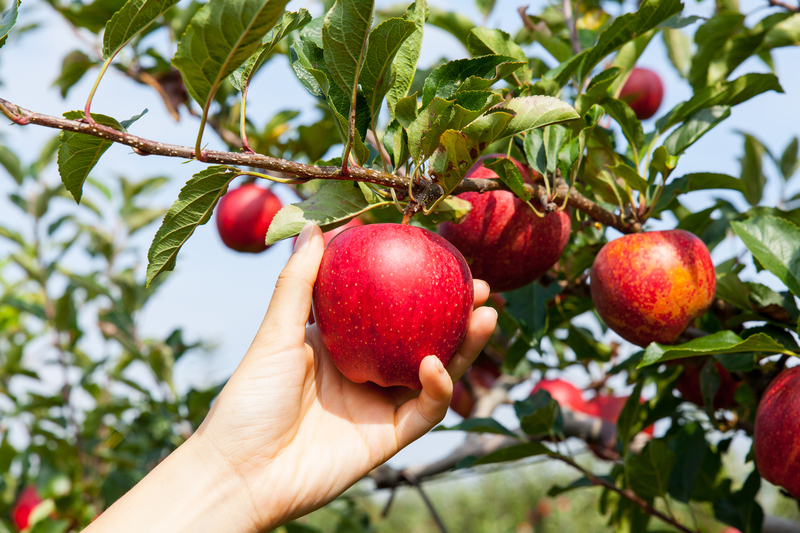Essential Tips to Safeguard Your Garden During Winter
Posted on 19/08/2025
Essential Tips to Safeguard Your Garden During Winter
As the vibrant colors of autumn fade, many gardeners begin to worry about the impending frost and chill of winter. Winter can pose numerous challenges for gardens -- from frost-bitten blooms to damaged roots. However, if you take the right precautions, you can not only protect your landscape but also set the stage for a flourishing garden come spring. In this in-depth guide, we'll delve into the best ways to protect your garden during winter, providing you with practical, easy-to-follow strategies that every gardener should know.

Why Is Winter Protection So Important for Gardens?
Winter brings about harsh conditions that can severely impact your plants and soil. Freezing temperatures, heavy snowfall, strong winds, and fluctuating moisture levels put your outdoor plants at risk. Tender plants and young saplings especially require attention because their roots and shoots are more susceptible to frost damage. Proper winter protection not only ensures survival but also vitality for the next growing season.
Before we get into essential winter garden safeguarding tips, let's discover the main reasons to protect your garden.
- Prevent frost damage: Freezing temperatures can kill or weaken plants, especially those unaccustomed to cold climates.
- Reduce soil erosion: Rain, snow, and wind can strip topsoil and nutrients away during winter.
- Preserve beneficial insects and soil life: Many helpful organisms overwinter in garden debris and soil; protecting their habitat helps keep your garden healthy.
- Keep your garden vibrant year-round: With proper care, you'll maintain a more attractive and robust winter garden landscape.
**Top Tips for Winterizing Your Garden**
1. Clean Up the Garden, but Leave Strategic Cover
A good autumn garden clean-up helps curb pests and diseases that could survive winter. Remove dead annuals, spent vegetables, and any diseased foliage. However, don't overdo it -- leave some healthy debris, such as seed heads and ornamental grasses, to provide shelter for beneficial insects and birds. This also adds winter interest to your landscape.
- Remove diseased plant material to prevent pathogens overwintering.
- Cut back perennials only if necessary, often the stems protect crowns from frost.
- Compost healthy plant matter and dispose of the rest.
2. Mulch, Mulch, Mulch
One of the most essential winter garden protection tips is mulching. Mulch acts as an insulator, keeping soil temperatures even, retaining moisture, and limiting freeze-thaw cycles that can harm roots.
- Apply 2-4 inches of organic mulch (e.g., straw, leaves, wood chips) around your plants, especially over root zones and the base of young trees.
- Keep mulch a few inches away from woody stems and tree trunks to prevent rot.
- For vegetable gardens, use straw or shredded leaves for easy removal in spring.
3. Protect Sensitive Plants and Trees
Some plants are less tolerant of cold temperatures. For these, consider winter plant protection measures:
- Burlap wraps or frost cloths: Wrap delicate shrubs, roses, and evergreens with breathable fabric for insulation.
- Cloche or cold frames: Use glass or plastic covers to shield tender perennials and winter vegetables.
- Move potted plants indoors: If you have potted citrus, herbs, or houseplants outside, bring them indoors to a cool, well-lit spot before the first frost.
*Tip: Water thoroughly before cold snaps. Moist soil retains heat better than dry soil and helps protect roots during freezes.*
4. Prune, but Not Too Early
Pruning in late fall can stimulate new growth, which is vulnerable to winter damage. Wait until plants are fully dormant (after several hard frosts), then trim away damaged branches. For fruit trees, the best time to prune is winter/early spring when they're asleep and easier to shape.
- Remove dead, damaged, or crossing limbs to prevent breakage from snow or ice.
- Avoid heavy pruning on spring-blooming shrubs until after they flower in spring.
5. Watering Your Winter Garden
Water is just as vital in winter as it is in the growing season. Dehydration is a common reason for winter plant loss. Water thoroughly before the ground freezes to give roots a chance to absorb moisture.
- On milder winter days, check soil moisture and water if dry, especially for evergreens.
- Avoid overwatering; the goal is to prevent drought, not to saturate soil.
6. Defend Against Winter Pests and Diseases
Some pests and pathogens remain active even in the coldest months. Protect your garden from winter insect pests by cleaning up hidden debris, using dormant oils on fruit trees, and checking stored vegetables for rot or infestation.
- Remove fallen fruit, leaves, and old mulch that could harbor overwintering insects.
- Regularly inspect plant stems and undersides of leaves for pests or eggs.
Extra Strategies to Prepare Your Garden for Harsh Winters
1. Shield Your Soil
Bare soil is prone to erosion and nutrient loss. Plant a winter cover crop, such as clover, winter rye, or vetch, in your vegetable and flower beds. These "green manures" protect the soil surface, add organic matter, and fix nutrients for the next season's crop.
- Sow cover crops right after harvesting annuals for best results.
- Cut and turn under cover crops several weeks before spring planting.
2. Install Windbreaks
If your garden is exposed to strong winter winds, consider adding temporary barriers, such as burlap screens or snow fences, to shield plants from windburn and desiccation.
- Place windbreaks on the side of prevailing winter winds for maximum protection.
- Remove or replace as needed to avoid accidental damage to plants.
3. Care for Garden Structures
Don't forget that winter garden care extends to your sheds, greenhouses, raised beds, trellises, and irrigation systems.
- Drain and store hoses and watering cans to prevent splitting or rust.
- Repair and check greenhouses for heat loss; insulate as needed.
- Clean and oil garden tools to prevent rusting during the off-season.
4. Keep Wildlife in Mind
Birds and helpful mammals play an important role in garden health. Leave seed heads, plant berries, and install birdhouses to provide food and shelter through winter.
- Put out a heated water source for birds and pollinators.
- Resist the urge to fully clear flowerbeds; some debris shelters beneficial creatures.
Winter Gardening: What About Winter Hardy Plants?
Some plants are naturally suited to cold temperatures and make fantastic additions to any garden aiming for winter resilience. Consider including these in your landscape:
- Evergreens: Spruce, pine, holly, and boxwood keep greenery all winter.
- Winter-flowering plants: Witch hazel, hellebores, winter jasmine, snowdrops.
- Cold-hardy vegetables: Kale, spinach, brussels sprouts, and leeks can survive and even thrive in frosty conditions with a little protection.
Choosing the right plant species for your climate zone can significantly reduce your winter garden maintenance.
Frequently Asked Questions
How do I protect my raised beds in winter?
Mulch heavily with straw or leaves, cover crops if possible, and use cold frames or row covers to insulate any overwintering vegetables or perennials in raised beds. Raised beds freeze faster than ground soil, so extra insulation is wise.
When should I start preparing my garden for winter?
Begin cleanup and mulching in late autumn, before the first hard frost. Tender potted plants should come indoors when night temps dip below 50?F (10?C).
Should I fertilize my garden before winter?
Hold off on most fertilizers in late fall, unless it's a slow-release organic amendment. Fertilizing perennials or trees late in the season can encourage new growth that may die back in winter freezes.
How can I keep evergreen shrubs from browning in winter?
Water evergreens thoroughly before the ground freezes, use anti-desiccant sprays if desired, and shield from direct wind with burlap screens. Heavy snowfall can also break branches, so brush off excess snow gently.

Proactive Winter Gardening: Planning for Spring
Winter is not only about protection. It's a crucial time for planning, reflection, and preparation for the next growing season. Here's how you can use the winter months for a head start:
- Order seeds and bulbs early - Many varieties sell out early. Make a list of what you want to plant in spring.
- Map your garden - Review successes and challenges from the past year, and plan your crop rotations or new flower arrangements.
- Start composting - Set up or tend to your compost pile to have nutrient-rich material ready for spring.
Conclusion: Safeguarding Your Garden in Winter Is Worth the Effort
With a little effort and these essential winter garden protection tips, you can minimize winter's damage and guarantee a lush, healthy landscape when the thaw arrives. The key is to act before the first hard frost, continue routine checks throughout the season, and tailor your efforts to your garden's unique needs.
Remember: mulching, sheltering tender plants, managing moisture, and caring for garden structures are the cornerstones of a well-protected winter garden. Embrace these practices, and you'll enjoy resilient perennial beds, thriving shrubs, and early vegetable harvests as soon as spring arrives.
Ready to put these tips into action? Start your winter garden preparations today and give your plants the best possible start for the seasons to come!

